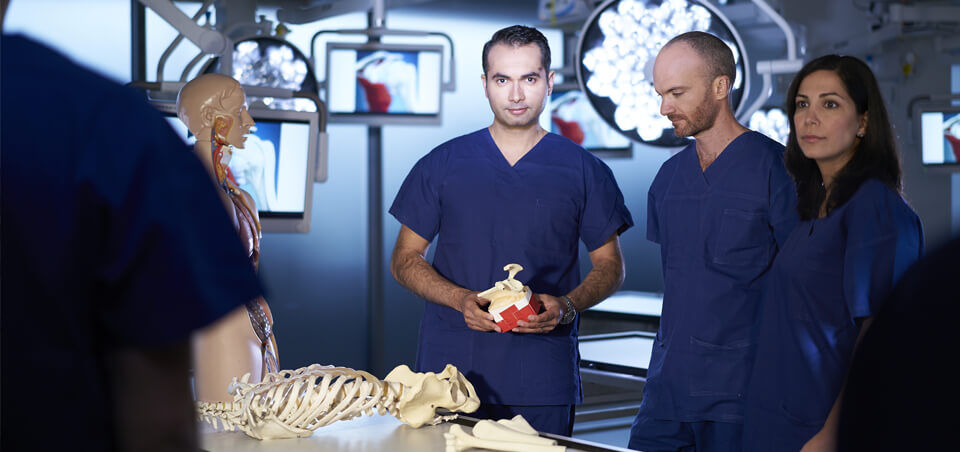Elbow Arthritis
Knowledge that empowers
What is it?
Arthritis is a degenerative condition affecting the smooth cartilage that lines the elbow joint. As this cartilage wears out, there is increasing load placed on the underlying bone.
This can eventually cause pain due to bone to bone friction and loss of range of movement due to bone deformity and abnormal bone formation. Osteoarthritis of the elbow is less common in comparison to many other joints, principally the hips, knees, and hands. It is nonetheless a debilitating problem and can have a significant impact on the patient’s life.

Who is affected?
Some people are more susceptible to osteoarthritis than others.
People who have worked in occupations involving manual labour (with repetitive impact like hammering), collision sports (like boxing or martial arts) or had previous trauma to the elbow may be at risk of developing osteoarthritis later in life.
Elbow arthritis is relatively more common in patients with underlying inflammatory arthritis such as Rheumatoid Arthritis. Rheumatoid arthritis is a condition in which the patients own immune system mistakenly attacks the joints causing widespread inflammation and damage, being the elbow joint is one of the targets.
What are the symptoms?
Pain in the elbow is often the most concerning symptom for those suffering from osteoarthritis of the elbow.
As the arthritis progresses, loss of movement or clicking and grinding sensations in the elbow may become more noticeable. In some cases, small loose bodies of bone or cartilage may form inside the elbow joint. These may cause pain, catching or locking as the elbow moves.
How is the diagnosis made?
A simple series of x-rays can help confirm the diagnosis of elbow osteoarthritis.
A CT scan may also be used to give a 3-dimensional view of the bones and joint surfaces of the elbow. In some cases, an MRI scan may be useful to detect loose bodies or rule out other causes for elbow pain. Pathology tests may be required to check for other arthritic conditions.
What is the prognosis?
Osteoarthritis tends to progress over time, however there is no way to predict how quickly or how advanced the condition may become, but generally depends on the level of activity with the affected arm.
Some patients function well for many years without treatment, and some patients require early treatment to help manage symptoms.
Non surgical treatment
For younger patients, or for those with manageable symptoms, the aim is to delay elbow replacement surgery as long as possible due to the wear that occurs on the surgical components once they are inserted.
Physiotherapy
While physiotherapy cannot ‘cure’ arthritis, your physiotherapist can provide advice on pain management, how to modify your activity and ways that you can stay physically active despite your elbow condition. Physiotherapy can also help to optimise the strength, mobility and function of your elbow.
No treatment
If pain is not severe and range of motion is not significantly affected, no immediate treatment may be needed. Some activity and lifestyle modifications might be required to avoid unnecessary irritation of the elbow.
Corticosteroid injection(s)
An injection of corticosteroid into the elbow joint can help control pain in people whose pain is not well controlled with medications. Corticosteroids are an anti-inflammatory that can help reduce pain associated with inflammation in elbow arthritis.
Should this be necessary, you will be referred to have this procedure under imaging guidance by a radiologist. If the injections provide good relief of pain, they can sometimes be repeated at periodic intervals. They do not usually increase movement of the elbow, but can help with pain control.
Surgical treatment
Elbow Arthroscopy
In those with moderate-severe osteoarthritis of the elbow, where range of motion is somewhat restricted and/or loose bodies are present inside the elbow joint creating elbow locking, an arthroscopic (keyhole) surgery may be beneficial to smooth out any bony prominences, remove loose bodies and, if necessary, release any soft tissues around the joint that may be contributing to restricted range of motion at the elbow.
Physiotherapy is critical following elbow arthroscopy to restore range of motion to the joint and optimise the strength and function of the arm following surgery.
Total Elbow Replacement
In some patients with severe arthritis of the elbow, replacement of the joint may be necessary to improve pain and range of motion at the elbow.
Total elbow arthroplasty (TEA) is much less commonly performed than other major joint arthroplasties. Currently, TEA is used for the increasing number of patients with osteoarthritis, posttraumatic arthritis, and complex distal humerus fractures.
In general, early and midterm outcomes with TEA demonstrate excellent pain relief and functional restoration. However, the rate of complications is greater than with other types of joint arthroplasty and presents diminished survivorship at 20 years.
Following total elbow replacement, you will be required to wear a sling or brace for approximately 6 weeks. Physiotherapist supervised rehabilitation takes approximately 4 months to complete.
